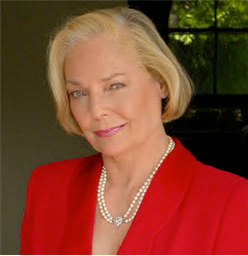The death of Judy Lewis at 76 tolls a very distinctive bell in Hollywood history: She is probably the last surviving love child of the now faintly illuminated figures who made up the Hollywood star system.

That system simply doesn’t boast a duo of scandalous lovers any bigger in acclaim, popularity, Oscar recognition and sensual wattage than her wayward parents, Clark Gable and Loretta Young.
Also read: Love Child of Clark Gable, Loretta Young Dies At 76
A Hollywood hierarchy that was suspicious of female star power dubbed Young “the steel butterfly,” and her treatment of her illegitimate daughter, judge it though we may, perfectly embodies that contradiction. So devout a Roman Catholic (she’d win her Oscar for playing a nun) that Joan Crawford once mocked her for it, she was too career-oriented to admit to motherhood, yet too tenderhearted to take the then drastic step of abortion, and would instead find complex dodges to see that the child was cared for.
Also read: From Steve Jobs to Elizabeth Taylor: Notable Celeb Deaths of 2011
She would not confess to mothering Joan until a confrontation in 1966.

When Young and Gable met on the set of “The Call of the Wild” in remote northern Washington state, he was fresh from an Oscar win for “It Happened One Night.” His bare-chested scene in the film was such a style-setter in the otherwise stodgy Thirties that years later, he apologized, “I didn’t know what I was doing to the undershirt people.”
Young had come out of silent pictures as what film historian Jeanine Basinger calls “a pretty young thing,” but would go on to be one actress "who outsmarted the star machine." Young was said to be “a perfectionist and a demanding artist — two attributes that had she been a man, might have earned her respect, but for a woman are often the kiss of death.”
And yet Young worked opposite every significant leading man of her era, including John Barrymore, James Cagney, Tyrone Power, Orson Welles, Gary Cooper, David Niven, Robert Mitchum, and Alan Ladd.
Just two years before meeting Gable she had fallen in love with Spencer Tracy while shooting “Man’s Castle.” She was a divorced woman of 20 (she'd eloped at 17 with an early co-star, setting a pattern of sorts), living with her mother Gladys, and he was a separated dad of two children. (Their shared Roman Catholicism prevented divorce, and Tracy and wife eventually reconciled.)
"The Call of the Wild” was a tough shoot, often fighting wintry conditions that fit the story but caused cast and crew ample misery. Feisty director “Wild Bill” Wellman, a former French Foreign Legionnaire, offered to fight the chronically tardy Gable one day.
The theory persists that Gable was too dumbstruck by his co-star’s appeal to focus on his work, and if you have a look at the YouTube clip of a campfire scene, with the high-cheekboned, magnificently proportioned Young lolling on her back in a clearly seductive pose, who can blame him?
Gable’s macho mutterings in the scene can’t match the magnetism exuded not just by Young but by the panting St. Bernard who sits with them. "I’m not the star in this play,” author Chrystopher J. Spicer describes Gable telling an interviewer. "A dog is the star in it."
As Spicer writes: “They were a pair of emotionally vulnerable people cut off from the outside world, acting out being in love on camera with no escape from each other when the cameras stopped rolling. What happened next was fairly inevitable.”
Young made confession to her biographer Joan Wester Anderson many years later that “the tryst happened on the train coming home,” and further related that Gable said to her mother Gladys, ”I thought she knew how to take care of herself. After all, she had been a married woman.”
A real reckoning would not come for many years, as Gable was soon off to Catalina Island to shoot “Mutiny on the Bounty.” Though he’d be nominated for an Oscar for his performance as Fletcher Christian, he insisted, “I stink in it”– perhaps because Young wouldn’t allow the lovesick actor to spend time with her.
The real poignant story belongs to Judy Lewis, who’s even more a victim of the times than the two parents whose thriving careers would not allow them to publicly take responsibility for her. Young and her mother slipped back into Los Angeles from Europe (where she’d shot “The Crusades”) with the actress visibly pregnant, and abandoned their Sunset Boulevard house in Bel-Air to retreat to a rental cottage Gladys had invested in.
Judy was born at 8612 Rindge St. in windswept southern Venice at 8:15 a.m. on November 6, 1935. Attended by a Dr. Holleran, Young put a hand over the infant’s mouth lest the milkman arriving outside hear her first cry.
That evening in Manhattan, Gable was in his hotel suiting up for a party when an unsigned telegram arrived telling of “a beautiful blue-eyed blonde girl.”
Gable tore the telegram into shreds and flushed it, and as well-detailed in Wednesday’s New York Times and Los Angeles Times accounts, only saw his illegitimate daughter a couple more times in her life.
Judy Lewis’s own story, of suffering though mockery for her outsize Gable-esque ears (with a corrective surgery at age 7), and of the quest to gain acknowledgment from her mother, and going on to a career in acting and in family counseling, is an admirable tale of personal redemption.
Young publicly acknowledged Lewis in an authorized biography published after her death in 2000.
A certain gloom hangs over the saga, a sense that Hollywood, even with the star system largely dismantled, is sooner able to forget than forgive. It’s a mood reminiscent of Loretta Young’s assessment of why Lon Chaney gave her her first film lead in 1928 when she was 15: “He said it was my sad smile.”